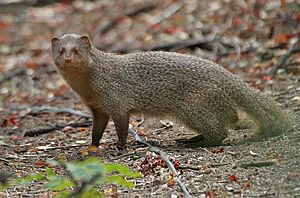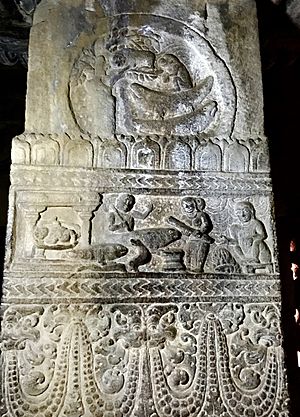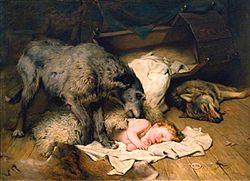The Brahmin and the Mongoose facts for kids
Quick facts for kids The Brahmin and the Mongoose |
|
|---|---|

|
|
| Folk tale | |
| Name | The Brahmin and the Mongoose |
| Data | |
| Aarne–Thompson grouping | 178A |
| Country | India (origin) |
The story of The Brahmin and the Mongoose (sometimes called The Brahmin's Wife and the Mongoose) is a very old and famous folktale from India. It's known as "one of the world's most travelled tales" because it has spread to many different countries. This tale teaches an important lesson: don't act too quickly or make decisions when you're angry or upset. It shows what can happen when someone makes a hasty choice without thinking. Similar stories are found in other parts of the world, like the legend of Llywelyn and his dog Gelert in Wales.
The Story of the Loyal Mongoose

The original version of this story comes from a collection of Indian fables called the Panchatantra, written in Sanskrit. Here's how the story goes:
In a certain town, there lived a wise man named God (also known as Devasharma), who was a Brahmin. He and his wife had a baby son. They also had a mongoose, which the wife loved very much. She cared for the mongoose just like her own child. She gave it milk, special creams, and even bathed it. However, she still worried a little, thinking, "A mongoose is a wild animal. What if it hurts my baby boy?"
One day, the wife put her baby to sleep in his cradle. She picked up a water jar and told her husband, "I'm going to get some water. Please protect our son from the mongoose while I'm gone." But after she left, the Brahmin also went out to find food, leaving the house empty.
While they were both away, a black snake slithered out of its hole. It moved towards the baby's cradle, ready to harm the child. But the mongoose saw the snake. Mongooses and snakes are natural enemies. The mongoose knew the snake was a danger to its baby brother. So, the brave mongoose attacked the snake. It fought hard, tearing the snake into many pieces.
Proud of its bravery, the mongoose ran outside to meet the mother. Blood was dripping from its mouth, showing what it had done. But when the mother saw the mongoose, she saw the blood and its excited movements. She immediately thought the mongoose had eaten her baby boy. Without thinking, she angrily dropped the heavy water jar on the mongoose. It died instantly.
She left the mongoose there and rushed into the house. There, she found her baby safe and sound in his cradle. Near the cradle, she saw the dead black snake, torn into pieces. Overwhelmed with sadness, she realized her terrible mistake. She had killed the loyal mongoose, who had saved her son. She cried and beat her head and chest in sorrow.
Just then, the Brahmin came home with a dish of rice porridge he had begged for. He saw his wife crying bitterly over the dead mongoose. She cried, "Oh, how greedy I was! Because you didn't do as I told you, now we suffer the pain of losing a child. This is what happens to those who are blinded by their own mistakes."
Variations of the Story
In different versions of this story, especially in Western countries, other animals sometimes take the place of the mongoose. Often, it's a dog, but it can also be a weasel, a cat (in Persia), a bear, or even a lion. The dangerous snake is sometimes replaced by a wolf, like in the Welsh story of Gelert. No matter the animal, the main message of the story stays the same. Also, in some versions, it's the man, not his wife, who mistakenly kills the loyal animal.
How the Story Traveled the World

The journey of this story, from India all the way to Wales, is one of the best examples of how folktales spread across the world. It was first studied in 1859 by Theodor Benfey, who compared different versions from India, the Middle East, and Europe. Later, in 1884, W. A. Clouston showed how it reached Wales.
This tale is found in all versions of the Panchatantra, as well as other old Indian books like the Hitopadesha and the Kathasaritsagara. It's very well-known across India and South Asia. For example, in the state of Karnataka in South India, you can find this story as a proverb, carved into temple sculptures, told by traveling storytellers, and even in movies! The ancient Tamil epic Silappatikaram even mentions the story just by its name, showing how famous it was.
Like many stories from the Panchatantra, this tale traveled west. It went from Sanskrit to Arabic (where it was called Kalila wa Dimna), then to Persian, Hebrew, Greek, Latin, Old French, and finally into all the major languages of Europe, from Russian to Gaelic and English. In Europe, it was often known as The Fables of Pilpay or Bidpai.
The story also traveled east, appearing in China (in ten different versions), and across a wide area from Mongolia to Malaysia. It's special because it's the only story found in all versions of the Panchatantra, all versions of the "Book of Sindibad," and all versions of "The Seven Sages of Rome."
Even today, the story is still told. It has appeared in Mexico and the United States. A newspaper in Belgium once reported a true story that was very similar: a man left his son and dog in a shopping trolley in his car, which echoed the old fable. The main idea of the story, with a happy ending, even appears in the Disney film Lady and the Tramp (1955).

